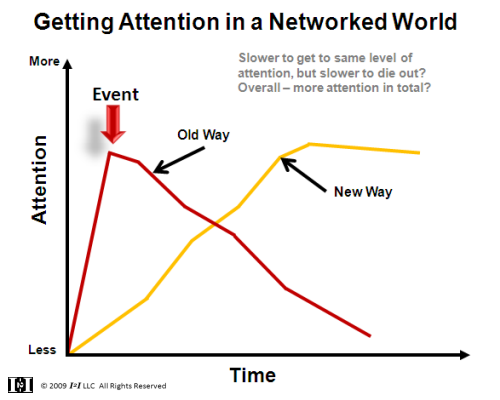I live by a philosophy that guides virtually every marketing decision I make – it’s okay to utilize assets, but spend resources only when it’s absolutely necessary. To understand why this philosophy is so important, we must first understand the difference between building what I refer to as “marketing assets” versus “spending marketing resources.”
Traditional marketing efforts are virtually all built on spending marketing resources. It is for this reason that the marketing budget exists solely on the income statement (or, more appropriately the expense statement) and doesn’t exist on the balance sheet.
The reality is that more than 95% of the time when a business owner, executive, or salesperson uses the word marketing they really mean advertising and/or promotion. Built upon the campaign mindset, traditional efforts focus on creating results through the sheer force of effort.
Tactics like cold calling, direct mail, print advertising, etc. all fall under this category. But, so do efforts like “going viral,” to increase “brand awareness;” and many other “new” marketing efforts. All of these tactics search to create an “event” that causes a message to break through the noise and gain the attention of a desired audience. The problem is that there is no foundation, relationship, or value creation to support the event or campaign. So, the only way to maintain their effect is to keep doing them.
Worse, because the rate of noise is increasing exponentially, what you did yesterday is not enough for tomorrow and you need to do more to raise the volume. To add insult to injury, as you get bigger, the only way for these tactics to support your growth is to scale them up with you. There’s simply no leverage or long-term benefit when spending marketing resources.
Marketing assets, on the other hand, build in value, impact and effect over time. While they don’t (always) have as an immediate impact as traditional efforts, the results you gain from them last. Because they last, as you do more, the value of doing them increases as well. They benefit from the network effect.
The biggest advantage that building marketing assets that once built, because they are assets and not campaigns, they take progressively less (never zero) effort to maintain them. As you maintain them, they continue to drive better results. This makes them highly leveragable (as virtually any strong asset is), and becomes a moat, or competitive advantage, if you will, that protects you and makes your competition increasingly irrelevant.
What are examples of marketing assets. As Seth Godin has made famous, probably the highest value-marketing asset is the permission of defined group of people. Tactics such as blogging, creating conversations on platforms like Twitter, and content marketing are prime examples. But, please (PLEASE) don’t ever confuse the tactic as being an asset. It’s the tactic driven to support a specific purpose, regularly monitored and constantly refined. The difference between these two approaches is best illustrated by this chart, created by Paul Hebert, at I2I.
So, why not just drop all of your traditional marketing tactics and focus exclusively on new ones? Obviously, the challenge with this is that if you've built a reliance on campaign driven advertising and promotion and you stop that cold, the inflow of business potentially stops as well. Your objective should be to develop a plan so that over the course of the next 18 to 24 months you realign at least 90% of your traditional efforts to new, asset based efforts. My experience says that it will take about six months to build a baseline of content, and you should consider this time an investment. At about six months, you'll want to begin reducing your investments (time, money and energy) from traditional tactics and put them towards a new strategy. Keep in mind that the biggest investment barrier in new strategies isn't money as much as it is time. You need - must - put in the time, or you will fail to build an asset.
One final note for all the traditional marketing cynics out there who may be saying that achieving "front-of-mind" status through traditional marketing tactics is in fact, an asset. You may even be rationalizing that the investments in traditional tactics create awareness and "build the brand." I'll concede that if you are McDonald's, Coca-Cola, Proctor & Gamble, Wal-Mart, etc. this may (emphasis on may) be true. But, these companies spend billions (with a "b") on advertising. As a small and mid-market business (SMB), you do not have the resources to "build the brand" that way. Besides, the smart "big guys" like Proctor and Gamble are already implementing the approach that I recommend - so why should you wait?

 Doug Davidoff
Doug Davidoff
